| Article ID | Journal | Published Year | Pages | File Type |
|---|---|---|---|---|
| 8476895 | Molecular and Cellular Endocrinology | 2015 | 27 Pages |
Abstract
Three potassium channels have been associated with primary aldosteronism (PA) in rodents and humans: KCNK3 (TASK-1), KCNK9 (TASK-3), and KCNJ5 (Kir3.4). Mice with deficiency in Kcnk3 and Kcnk9 have elevated aldosterone production and blood pressure. In humans, adrenal tumors with somatic mutations in KCNJ5 cause PA. However, there are very few reports on the expression patterns of these genes in humans versus rodents. Herein, we compared human and rat mRNA expression (by quantitative real-time polymerase chain reaction (qPCR) and protein levels (by immunohistochemistry) across three tissues (adrenal, brain, heart) and two laser-captured adrenal zones (zona glomerulosa, zona fasciculata). Our findings show that expression patterns of KCNK3, KCNK9, and KCNJ5 are inconsistent between rats and humans across both tissues and adrenal zones. Thus, species variation in the expression of PA-related potassium channels indicates an evolutionary divergence in their role in regulating adrenal aldosterone production.
Related Topics
Life Sciences
Biochemistry, Genetics and Molecular Biology
Cell Biology
Authors
Andrew X. Chen, Koshiro Nishimoto, Kazutaka Nanba, William E. Rainey,
